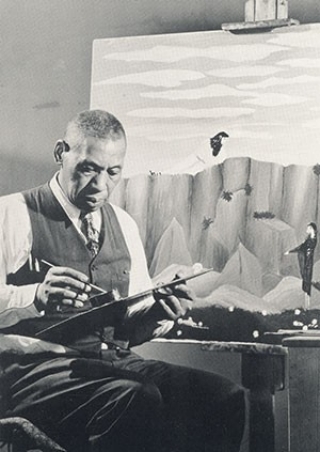Born 1888, died 1946, West Chester, Pennsylvania
A military veteran wounded during World War I, Pippin was a self-taught African American painter who attracted attention amid the national fascination with “folk,” “primitive,” and “naïve” art in the late 1930s and 1940s. After receiving an honorable discharge from the army, Pippin drew on discarded cigar boxes or burned images onto wood panels before turning to oil painting in 1928. Following a solo exhibition at the West Chester Community Center in 1937, his work was included in MoMA’s Masters of Popular Painting (1938). His painted recollections of war as well as his history paintings, genre scenes, still lifes, and portraits were praised for their freedom from academic pretension and their resonance with modes of modernist abstraction by curators and collectors such as folk art authorities Holger Cahill and Edith Halpert.
Early in his career Pippin evoked the chaos of war in images such as Dogfight over the Trenches before transitioning to historical subjects like the life of abolitionist John Brown. John Brown Going to His Hanging represents a fictional reconstruction of the moment just before Brown was put to death, as a crowd awaits his execution. A solitary black woman in the right foreground, possibly Pippin’s grandmother, stares out at the viewer in anger as the leader of black liberation proceeds to the gallows. Pippin’s Holy Mountain III, based on Edward Hicks’s renowned series of paintings on the Peaceable Kingdom, presents an outwardly pastoral scene, replete with vegetation and wildlife. Yet Pippin subtly undermines the illusion of an idyllic landscape. Beside his signature at the lower right corner, he inscribed the date “Aug 9, 1945,” the day the US dropped an atom bomb on Nagasaki. Further examination reveals other dark details: murky figures of soldiers in the woods seem engaged in battle at the right; small crosses mark burial sites in the center; and a lynched body hangs from a tree on the left. Synthesizing his early works’ concentration on armed combat with the racial brutality faced by African Americans in the US, the painting is less a peaceful prophecy than a commentary on enduring tension and violence.
Nicholas Miller
Lewis, Audrey, ed. Horace Pippin: The Way I See It. New York: Scala Arts Publishers, 2015.
Stein, Judith. I Tell My Heart: The Art of Horace Pippin. Philadelphia: Pennsylvania Academy of the Fine Arts, 1994.
